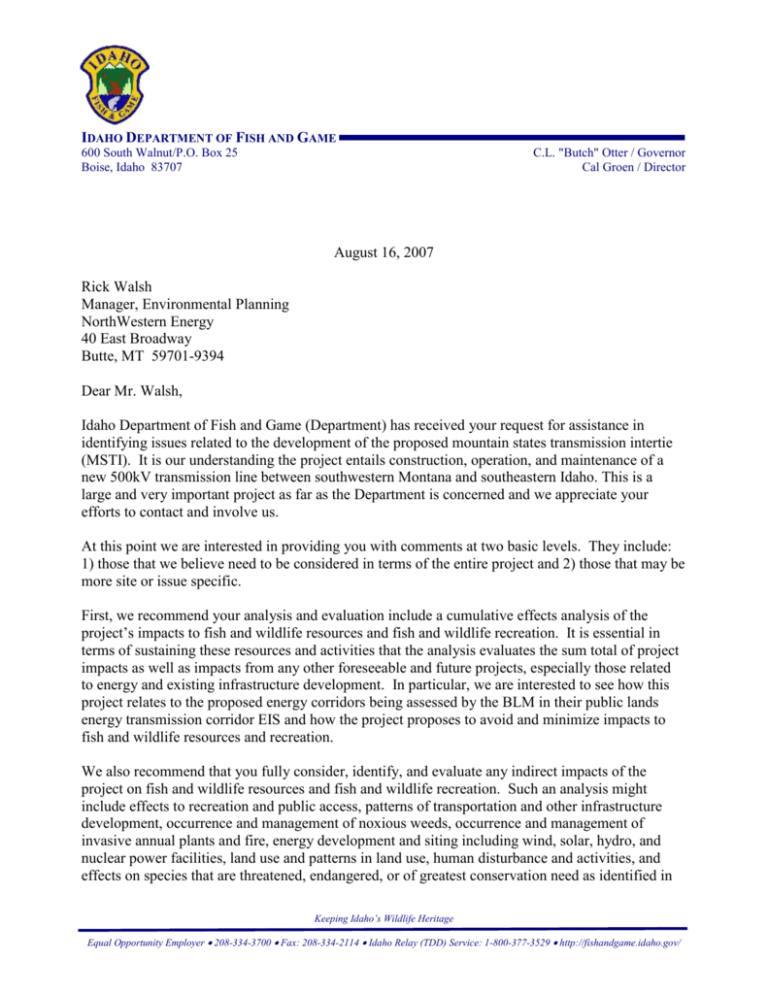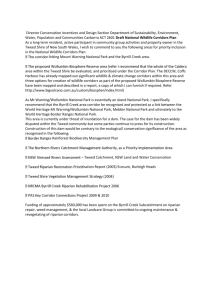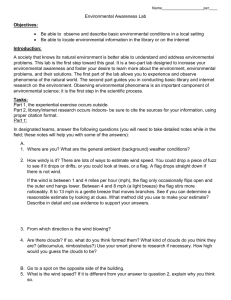State of Idaho
advertisement

IDAHO DEPARTMENT OF FISH AND GAME 600 South Walnut/P.O. Box 25 Boise, Idaho 83707 C.L. "Butch" Otter / Governor Cal Groen / Director August 16, 2007 Rick Walsh Manager, Environmental Planning NorthWestern Energy 40 East Broadway Butte, MT 59701-9394 Dear Mr. Walsh, Idaho Department of Fish and Game (Department) has received your request for assistance in identifying issues related to the development of the proposed mountain states transmission intertie (MSTI). It is our understanding the project entails construction, operation, and maintenance of a new 500kV transmission line between southwestern Montana and southeastern Idaho. This is a large and very important project as far as the Department is concerned and we appreciate your efforts to contact and involve us. At this point we are interested in providing you with comments at two basic levels. They include: 1) those that we believe need to be considered in terms of the entire project and 2) those that may be more site or issue specific. First, we recommend your analysis and evaluation include a cumulative effects analysis of the project’s impacts to fish and wildlife resources and fish and wildlife recreation. It is essential in terms of sustaining these resources and activities that the analysis evaluates the sum total of project impacts as well as impacts from any other foreseeable and future projects, especially those related to energy and existing infrastructure development. In particular, we are interested to see how this project relates to the proposed energy corridors being assessed by the BLM in their public lands energy transmission corridor EIS and how the project proposes to avoid and minimize impacts to fish and wildlife resources and recreation. We also recommend that you fully consider, identify, and evaluate any indirect impacts of the project on fish and wildlife resources and fish and wildlife recreation. Such an analysis might include effects to recreation and public access, patterns of transportation and other infrastructure development, occurrence and management of noxious weeds, occurrence and management of invasive annual plants and fire, energy development and siting including wind, solar, hydro, and nuclear power facilities, land use and patterns in land use, human disturbance and activities, and effects on species that are threatened, endangered, or of greatest conservation need as identified in Keeping Idaho’s Wildlife Heritage Equal Opportunity Employer 208-334-3700 Fax: 208-334-2114 Idaho Relay (TDD) Service: 1-800-377-3529 http://fishandgame.idaho.gov/ the Idaho Comprehensive Wildlife Conservation Strategy (http://fishandgame.idaho.gov/cms/tech/CDC/cwcs_table_of_contents.cfm). Finally, we offer the following as a preliminary list of issues you should consider in your analysis of this project. 1. Migratory corridors for elk, mule deer, moose, and pronghorn. Migratory corridors of varying use and size are found within the alternative transmission corridors. 2. Elk, mule deer, moose, and pronghorn winter range. Several of the alternative transmission corridors are in or near designated big game winter ranges. 3. Sage-grouse and sharp-tailed grouse populations and habitats. Several of the alternative transmission corridors are in, or near known grouse breeding habitat. Grouse may avoid or abandon otherwise suitable breeding habitat, brood areas, and other habitats near tall structures. Towers with perching sites for raptors and nesting sites for corvids could reduce lek attendance and increase grouse predation and nest depredation rates. 4. Waterfowl and shorebird high-use areas. Portions of the alternative transmission corridors are near known concentration areas for waterfowl; such as Camas National Wildlife Refuge, Carey Lake, Sterling, and Mud Lake Wildlife Management Areas, and American Falls Reservoir. 5. Waterfowl and shorebird migration routes. Seasonal waterfowl and shorebird migration routes are located near the alternative transmission corridors. 6. Passerine migration routes. Although poorly documented, seasonal passerine migration routes are likely located near or within the alternative transmission corridors. 7. Bat populations and habitats. The Department has documented populations of bats near the alternative transmission corridors. While the affects of large power lines on bats are unknown, potential direct and indirect impacts could occur. 8. Reptile populations and habitats. Direct and indirect impacts of transmission corridor construction, operation, and maintenance on reptile populations and habitat; particularly hibernacula. Several reptile species of greatest conservation need occur within the alternative transmission corridors. 9. Raptor populations and habitats. Direct and indirect impacts of transmission corridor construction, operation, and maintenance on resident and migratory raptor populations and habitats. 10. Pygmy rabbit populations and habitats. Loss and fragmentation of pygmy rabbit habitat through direct footprint effects and secondary project effects such as habitat fragmentation. 11. Large carnivore populations and habitats. Project effects on large carnivore (grizzly bear, wolf, wolverine) populations and habitats, including linkage corridors and genetic interchange, between Yellowstone Ecosystem and Central Idaho Wilderness areas. 12. Vehicle access to game ranges, especially big game winter ranges. Increased motorized access to winter ranges is a concern of the Department. Road construction as a result of this project and the potential for increased public access through construction and service roads can negatively impact wildlife and wildlife use of habitats. 13. The location of the transmission corridors in relation to rare and/or sensitive wildlife habitats including kipukas, lava tubes, caves (natural and man-made), permanent and seasonal wetlands, and riparian areas. 14. The location of transmission corridors in relation to special status plant habitats and populations. Keeping Idaho’s Wildlife Heritage Equal Opportunity Employer 208-334-3700 Fax: 208-334-2114 Idaho Relay (TDD) Service: 1-800-377-3529 http://fishandgame.idaho.gov/ 15. The location of transmission corridors in relation to critical habitats such as white-bark pine stands (Montana/Idaho boarder). 16. Fragmentation of large contiguous blocks of wildlife habitats a result of transmission corridor construction, operation, and maintenance. 17. Restoration and mitigation of impacts due to the project footprint. We are interested in ensuring there is no net loss of habitat as a result of the project. 18. Monitoring and evaluation of resources. Relatively little is known about the wildlife and wildlife habitats of the project area. Baseline information is necessary to understand and reduce project impacts. Monitoring the effects of the project is also necessary to determine its real impacts and to accordingly adapt any mitigation, design, operation, and management of the project. Additionally, as outlined on the maps we were provided, the project could potentially affect the fish and wildlife resources of three different regions of our state. Although this letter provides you the initial comments of the Department, site-specific concerns as well data and information may often best come from the regional offices in each of these areas. For your information, these offices and contact persons include: 1) Idaho Falls, 208-525-7290, Gary Vecellio, 2) Pocatello, 208-232-4703, Jim Mende, and 3) Jerome, 208-324-4359, Mike McDonald. However, where efficiency and coordination are necessary, I remain your contact person for the Department and will provide all help necessary to coordinate and assemble inquiries, data, and information that would be applicable to your project planning and evaluation. Thank you. Sincerely, Gregg Servheen Wildlife Program Coordinator Idaho Department of Fish and Game 208-287-2713 Cc: Vecellio, IDFG Mende, IDFG McDonald, IDFG Church, IDFG Bob Brammer, IDL Tom Dyer, BLM Director Lori Armstrong, BLM Shoshone Field Office Scott Feldhausen, BLM Burley Field Office Wendy Reynolds, BLM Upper Snake Field Office Dave Pacioretty, BLM Pocatello Field Office Craters of the Moon National Monument and Preserve Keeping Idaho’s Wildlife Heritage Equal Opportunity Employer 208-334-3700 Fax: 208-334-2114 Idaho Relay (TDD) Service: 1-800-377-3529 http://fishandgame.idaho.gov/








